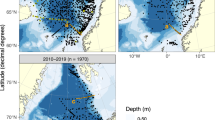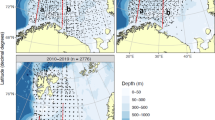Abstract
Plumes of neritic sediment caused by the passage of Hurricane Gert near Bermuda in 1999, and by the passage of Hurricane Michelle over Cuba’s Gulf of Batabano in 2001, were observed by the Sea-viewing Wide Field-of-view Sensor (SeaWiFS). The mass of sediments in each of these plumes, which consist largely of neritic carbonate particles, was estimated using an algorithm for the calculation of suspended sediment concentrations. The Bermuda and Batabano plumes transported 0.22 and 1.2–1.35 million kg of sediment, respectively. The algorithm results were compared with the results from two other sediment mass algorithms and proved to be consistent. These results indicate the potential use of remote sensing to estimate carbonate flux from coral reefs and banks and atolls as an augmentation to in situ studies. In addition, the use of remote sensing data may improve estimates of the annual global carbonate sediment flux, a quantity important to models of global carbonate production and the global carbon cycle.






Similar content being viewed by others
References
Acker JG, Brown CW, Hine AC (1997) The CORSAGE programme: continuous orbital remote sensing of archipelagic geochemical effects. Int J Remote Sensing 18:305–321
Acker JG, Brown CW, Hine AC, Armstrong E, Kuring N (2002) Satellite remote sensing observation and aerial photography of storm-induced neritic carbonate transport from shallow carbonate platforms. Int J Remote Sensing 23:2853–2868
Ahn Y-H, Moon J-E, Gallegos S (2002) Development of suspended particulate matter algorithms for ocean color remote sensing. Proc Ocean Optics XVI Santa Fe: Paper 242
Althuis IJA, Vogelzang J, Wernand MR, Shimwell SJ, Gieskes WWC, Warnock RE, Kromkamp J, Wouts R, Zevenboom W (1996) On the colour of Case 2 waters: particulate matter North Sea, part I: results and conclusions. Report 95-21B, Netherlands Remote Sensing Board
Baker KS, Smith RC (1990) Irradiance transmittance through the air–water surface. Ocean Optics X. SPIE Proceedings, vol 1302, pp 556–565
Burenkov VI, Vasilkov AP, Stephantsev LA (1995) Retrieval of spectral inherent optical properties of seawater from the spectral reflectance. Oceanology 25:49–54
Carder KL, Hawes SK, Baker KA, Smith RC, Steward RG, Mitchell BG (1991) Reflectance model for quantifying chlorophyll a in the presence of productivity degradation products. J Geophys Res 96:20559–20611
Delesalle B, Buscail R, Carbonne J, Courp T, Dufour V, Heussner S, Monaco A, Schrimm M (1998) Direct measurements of carbon and carbonate export from a coral reef ecosystem (Moorea Island, French Polynesia). Coral Reefs 17:121–132
Garver SA, Siegel DA (1997) Inherent optical property inversion of ocean color spectra and its biogeochemical interpretation. 1. Time series from the Sargasso Sea. J Geophys Res 102:18607–18625
Gordon HR, Morel A (1983) Remote assessment of ocean color for interpretation of satellite visible imagery. A review. Lecture notes on coastal and estuarine studies, vol 4. Springer, Berlin Heidelberg New York
Gordon HR, Brown OB, Evans RH, Brown JW, Smith RC, Baker KS, Clark DK (1988) A semianalytic radiance model of ocean color. J Geophys Res 93:10909–10924
Gould RW Jr., Stavn RH, Twardowski MS, Lamela GM (2002) Partitioning optical properties into organic and inorganic components from ocean color imagery. Proc Ocean Optics XVI Santa Fe: Paper 091
Hine AC, Wilber RJ, Bane JM, Neumann AC, Lorenson KR (1981) Offbank transport of carbonate sands along open leeward bank margins: northern Bahamas. Mar Geol 42:327–348
Hoge FE, Lyon PE (1996) Satellite retrieval of inherent optical properties by linear matrix inversion of oceanic radiance models: an analysis of model and radiance measurement errors. J Geophys Res 101(C7):16631–16648
Hubbard DK (1992) Hurricane-induced sediment transport in open-shelf tropical systems: an example from St. Croix, US Virgin Islands. J Sediment Petrol 62:946–60
Hubbard DK, Miller AI, Scatturo D (1990) Production and cycling of calcium carbonate in a shelf-edge reef system (Ste Croix, US Virgin Islands): application to the nature of reef systems in the fossil record. J Sediment Petrol 60:335–336
Iglesias-Rodriguez D, Armstrong R, Feely R, Hood R, Kleypas J (2001) SMP workshop assesses role of calcification in ocean carbon cycle. US JGOFS News 11(3):9–10
Iglesias-Rodriguez D, Armstrong R, Feely R, Hood R, Kleypas J, Milliman JD, Sabine C, Sarmiento J (2002) Progress made in study of ocean’s calcium carbonate budget. EOS Trans Am Geophys Union 83:365, 374–375
Lee Z, Carder KL, Hawes SK, Steward RG, Peacock TG, Davis CO (1994) Model for the interpretation of hyperspectral remote-sensing reflectance. Appl Opt 33:5721–5732
Milliman JD (1993) Production and accumulation of calcium carbonate in the ocean: budget of a nonsteady state. Global Biogeochem Cycles 7:927–957
Milliman JD, Droxler AW (1996) Neritic and pelagic carbonate sedimentation in the marine environment: ignorance is not bliss. Geol Rundsch 85:496–504
Morel A (1988) Optical modelling of the upper ocean in relation to its biogenous matter content (case 1 waters), J Geophys Res 93:10749–10768
Ouillon S, Douillet P, Andréfouët S (2003) Coupling satellite data, in situ measurements and numerical modeling to study fine suspended sediment transport: a first attempt over the lagoon of New Caledonia. Coral Reefs (this issue)
Pope RM, Fry ES (1997) Absorption spectrum (380–700 nm) of pure water. II. Integrating cavity measurements. Appl Optics 36:8710–8723
Roesler CS, Perry MJ (1995) In situ phytoplankton absorption, fluorescence emission, and particulate backscattering spectra determined from reflectance. J Geophys Res 102:13279–13294
Sabine CL, Mackenzie FT (1995) Bank-derived carbonate sediment transport and dissolution in the Hawaiian archipelago. Aquatic Geochem 1:189–230
Schrimm M, Heussner S, Buscail R (2002) Seasonal variations of downward particle fluxes in front of a reef pass (Moorea Island, French Polynesia). Oceanol Acta 25:61–70
Sugihara S, Kishino M, Okami N (1985) Estimation of water quality parameters from irradiance reflectance using optical models. J Oceanogr Soc Jpn 41:399–406
Tassan S (1994) Local algorithms using SeaWiFS data for the retrieval of phytoplankton pigments, suspended sediment, and yellow substance in coastal waters. Appl Optics 33:2369–2378
Vasilkov AP (1997) A retrieval of coastal water constituent concentrations by least-square inversion of a radiance model. Proc 4th Int Conf Remote Sensing Mar Coast Environ, Orlando, Florida, vol II, pp 107–116
Vecsei A (2001) Carbonate production potential on the world’s low latitude isolated banks. Proc 21st IAS Meeting of Sedimentology, Davos, Switzerland
Wilber RJ, Milliman JD, Halley RB (1990) Accumulation of Holocene banktop sediment of the western margin of Grand Bahama Bank: modern progradation of a carbonate megaband. Geology 18:970–974
Wilson PA, Roberts HH (1992) Carbonate-periplatform sedimentation by density flows: a mechanism for rapid off-bank and vertical transport of shallow-water fines. Geology 20:713–716
Acknowledgements
We are grateful to Dr. Richard Gould of the Naval Research Laboratory, Stennis Space Center, Mississippi and Paul Martinolich of Neptune Science Inc. for processing the data files with their algorithm and providing the results for our examination. We are also grateful to Dr. Yu-Hwan Ahn for processing the data files with his algorithm and providing these results to us. SeaWiFS data are the property of Orbimage, Inc. and are used for this research in accordance with the SeaWiFS Research Data Terms and Conditions Agreement of the NASA SeaWiFS Project. We would also like to acknowledge the operators of the HRPT stations at the Bermuda Biological Station for Research and the University of South Florida Institute for Marine Remote Sensing (ImaRS) for acquiring the SeaWiFS data used for this research.
Author information
Authors and Affiliations
Corresponding author
Additional information
James G. Acker and Denis Nadeau are employed by Science Systems and Applications, Inc.
Rights and permissions
About this article
Cite this article
Acker, J.G., Vasilkov, A., Nadeau, D. et al. Use of SeaWiFS ocean color data to estimate neritic sediment mass transport from carbonate platforms for two hurricane-forced events. Coral Reefs 23, 39–47 (2004). https://doi.org/10.1007/s00338-003-0355-9
Received:
Accepted:
Published:
Issue Date:
DOI: https://doi.org/10.1007/s00338-003-0355-9




